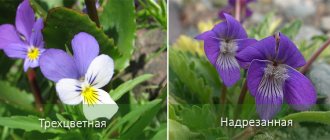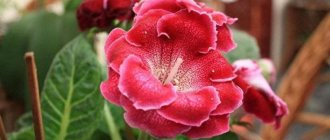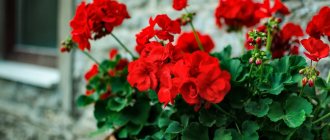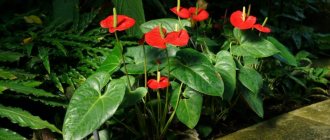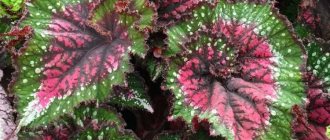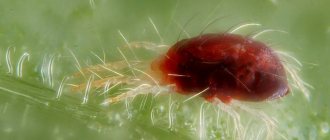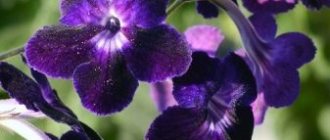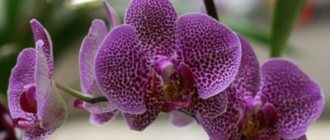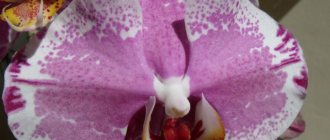What kind of plant is this?
What kind of orchid is this magnificent phalaenopsis?
The name phalaenopsis unites not one, but several varieties of orchids, bred specifically for home cultivation. All of them are unpretentious and feel great in modern homes.
Phalaenopsis belongs to the Orchidaceae family . In nature, these flowers grow either in the form of herbaceous bushes on trees, or in lithophytic herbaceous groups on the surface of the earth.
Habitat: Philippines, northeastern Australia, southeast Asia, Pacific Islands. Orchids prefer a height of 200-400 meters above sea level, rocks in the depths of tropical rainforests, trunks and crowns of trees.
Orchid care
Any windows are suitable for placement. But when kept on windows facing southeast, south and southwest, protecting plants from direct light in spring and summer is mandatory!
The more light a phalaenopsis receives, the smaller the area of its leaves and the worse it will tolerate a lack of light in winter, especially if it blooms. Moreover, if the plant produces a flower stalk in the fall, then without lighting the buds may dry out.
The same thing happens if phalaenopsis is located near a large number of apples or other fruits that emit ethylene. Sometimes even a large bouquet of fading flowers placed nearby can cause buds to fall off.
Detailed description
Phalaenopsis have monopodial branching and grow in one direction .
The stem is short and thin. The leaves are leathery, dense, wide. They have an oblong-oval shape, located opposite in rosettes. Their width ranges from 5 to 10 cm, their length can reach 50 cm (in nature) and 30 cm (in culture). Evergreen, often have a marbled pattern. An adult plant usually has 5-6 of them. The roots are aerial with a thick layer of velamen and grow from the axils between the leaves. Condenses and absorbs dew and rainwater. Peduncles are long, arched, bearing 15-20 flowers. The flowers are large, 5-10 cm in diameter.
The color is rich, the color palette is varied: the petals can be either single-colored (pink, white, red, lilac, yellow, lilac) or variegated (with spots, stripes, specks). The bouquet lasts up to 4 months . The flower “lip” stands out in contrast against the background of the petals. Phalaenopsis can bloom at any time and up to 3 times a year. The size of an orchid ranges from 30 cm (miniature) to 1 meter (regular).
Variety of species
Currently, there are about 70 main varieties and an incredible number of phalaenopsis hybrids bred by breeders. The following species are mainly common in home floriculture.
Spotted
The second name of the variety is Maroon Moths (due to the unusual spotted color). The shape of the flowers resembles a butterfly. Diameter - 8 cm. Color of the main background - cream, white, yellow, white. The petals are decorated with contrasting, irregularly shaped spots.
The leaves of the variety are dense, leathery, dark green in color, with a waxy sheen on the surface. The shape of the leaf blade is oblong-oval. The average height of the plant is 100 cm.
Cambridge
The main advantage of the Cambridge variety is its huge flowers, up to 11 cm in diameter. The color of the petals is snow-white, the center is bright yellow. It has long flowering.
Schiller
A large plant up to 30 cm high. The width of the leaves is about 6 cm. Like all phalaenopsis, the flower resembles a butterfly, but the structure of the petals has some features: sepals of a regular elliptical shape, diamond-shaped petals, curved back. The diameter of the flowers is 8-9 cm. The lip is triple, with a round center, a kind of anchor at the end and curved sides. The color of the flowers, depending on the variety, is white, pink, purple. Under suitable conditions, the species blooms in a cascade.
Sogo
The variegated Sogo species stands out among other phalaenopsis due to its original leaf color. They can be red-green, white-green, green-violet. The color stripes are arranged differently.
Flower colors are also widely available. The most common varieties are those with bright yellow, purple, lilac, and white petals.
Liodoro
A hybrid obtained by crossing the varieties Phalaenopsis Deventeriana and Phalaenopsis violacea. The author of Liodoro is American breeder Rex Smith. During its existence, since the late 80s, the hybrid has won 30 different awards in the field of floriculture.
Stem height is 45-50 cm. The leaves are elongated, elongated, up to 25 cm long, 10-12 cm wide. The flower is shaped like a star with a diameter of up to 7 cm. The color of the petals is yellow, purple, pink. Some varieties have petals decorated with small splashes of red.
Mini Mark
A miniature hybrid up to 20 cm high. The leaves are elongated, up to 10-15 cm, bright green. The flowers are small, 3-4 cm in diameter, elegant in shape. The petals are white, with multi-colored specks. The lip is bright orange.
Sakura
The variety was bred in Central Asia. It received the name Sakura due to the similarity of the flowers with the Japanese cherry. The stem of the plant is straight, about 60 cm high. The leaves of the species are large, rich green, forming a leaf rosette from which shoots and roots are formed.
The peduncle is 30-45 cm high. The flowers are light pink, with a lilac edging along the edge of the petals. The core is yellow or orange.
History of origin
The first mentions of this culture contain Chinese chronicles compiled 2500 BC, and the first flower was found in the distant 18th century by a traveler from Germany Georg Rimpfius , traveling through the Moluccas.
But the plant appeared in the first botanical reference book only in 1752, when another German naturalist, Carl Linnaeus, came into possession of a herbarium containing several carefully dried specimens of an outlandish flower. He gave it the first name Epidendrum amabilis - “living on a tree.”
Almost seven decades later, Blume, director of the botanical garden of Leiden, discovered several more specimens in the Malay Archipelago, and gave them another name Phalaenopsis - from the Greek words “Phalania” (night butterfly) and “Opsis” (resemblance).
The plant appeared in European botanical gardens at the beginning of the 19th century . The price for each specimen reached sky-high heights, and only monarchs could afford to purchase phalaenopsis for their personal collections.
In the 20th century, scientist-enthusiasts Knudson and More, independently of each other, developed the first hybrid, which easily crossed with other orchids. Anyone could now breed the variety. Hundreds of books have been written where you can read everything about it - the beautiful phalaenopsis, how to grow it yourself at home, how to replant and propagate.
How long do they live at home? Is it possible to extend life?
If the owner strictly follows all the standards of care, waters it correctly and, of course, showers his flower with love, the phalaenopsis can live in the house for 7-8 years .
Science knows of long-lived orchids, whose age was more than two hundred years.
Read about how to find out the age of a phalaenopsis orchid and rejuvenate it here.
Advantages and disadvantages of a flower
Like any other flower, the orchid has a number of advantages and some disadvantages. The latter often force one to abandon the idea of growing such flowers at home in a closed system. Among the advantages it should be noted:
- unusually beautiful large flowers;
- very pleasant aroma;
- long flowering period;
- no need for annual plant replanting;
- there is no need to water such a plant crop too often;
- Problem plants whose leaves have begun to turn yellow and fall off can be easily restored.
The main disadvantage of this flower is its demanding growing conditions. If mistakes are made, the plant can die quite quickly. Another disadvantage is the fragile foliage, which is prone to falling and changing color. Orchid leaves are very easily damaged.
In addition, you should know that orchids are prone to rotting of the root collar and root system. The lower leaves die quickly when over- or under-watered. Small midges may appear on the plant, which damage the flower.
What is the difference from other types?
- Phalaenopsis does not have false bulbs (tuberidia).
- The substrate serves as a support, so you can use light soil.
- Blooms several times a year.
- Monopodial growth.
- The air needs more moisture.
- The flowers are always larger.
- The leaves are semicircular.
We talked in more detail about the difference between phalaenopsis and other orchids in this article.
Characteristics of subvarieties and photos with names
The genus includes approximately 70 species of phalaenopsis, and there are several times more hybrid forms . In the photo you can see what home flowers look like. The most popular for growing at home are:
Amabilis
Phalaenopsis Amabilis (fariyatny) is the most suitable for crossing, the progenitor of many orchids.
Schiller
It blooms over and over again and can do so for a long period.
Pink
A miniature species, phalaenopsis flowers reach 3 cm in diameter .
Horse
Blooms all year round, especially abundantly in spring and autumn.
Giant
The leaves can grow up to a meter in length. The orchid is loved by breeders and biologists and is suitable for breeding new varieties .
Staghorn
Yellow-golden color with brown specks. The peduncle has a comb-like outgrowth.
Stewart
It has a branching peduncle up to 80 cm long.
Luddemann
The flowers are purple-pink and open one by one.
Sandera
A very beautiful and rare variety with long drooping peduncles , which can bear up to 50 flowers.
Ambuanian
Grows in the shade, blooms in the summer months, produces several flower stalks at the same time.
Parisha
Another miniature variety: peduncle – 14 cm, leaves – 18 cm, flowers – 2 cm. It has a pleasant aroma.
Hieroglyphic
Lemon-yellow strokes are drawn on the white background of the petals . The flowers smell delicious.
Philadelphia
Hybrid of Stewart and Schiller varieties. The flowers are small, purple-pink, with a marble pattern on the leaves.
Differences between domestic and wild phalaenopsis
The name Phalaenopsis combines both natural species and numerous hybrid varieties.
In modern botany, more than 5,000 artificially bred varieties are already known. They differ significantly from their “wild” ancestors.
In nature , an orchid can live up to 100 years , but in apartment conditions its lifespan is limited.
The most obvious difference is the direction of growth. Cultivated orchids do without vertical support and grow upward well.
The flowers of domestic varieties are much larger , but number several times less than that of phalaenopsis growing in tropical forests.
At home, the orchid does not propagate by seeds , since this is a labor-intensive, lengthy process, for which it is necessary to create laboratory conditions with complete sterility.
Bloom
When and how?
Flowering most often occurs 2 times a year, sometimes 3 . The number of flowers on a peduncle varies from 3 to 40 pieces. Flowering duration is from 2 to 6 months.
Features of care before and after
For successful flowering, an orchid must create optimal conditions:
- place it on a south, west or east window;
- do not flood;
- fertilize 1-2 times a month;
- install additional lamps for lighting.
We invite you to watch a video on how to prolong the flowering of the Phalaenopsis orchid:
What to do if flowers don't appear?
If all of the above conditions have been met, but the orchid refuses to bloom, you can try to stimulate the process: take the plant to a glassed-in balcony from a warm room. The difference between night and day temperatures contributes to more intense and lush flowering .
If the owner overfeeds the plant, it begins to grow green mass rather than bloom. Therefore, you will need to abandon fertilizing for a while.
Replanting a phalaenopsis orchid
What you need to know about phalaenopsis is that it does not tolerate transplantation and any root trauma. Therefore, it is not replanted annually, but as needed, in the following cases:
- if the plant has been heavily flooded and there are rotten roots
- the soil has deteriorated, rotted, become soggy, crumbled badly and turned into dust
- the pot smells bad
- oribatid mites crawling out of the pot
- root pests have appeared
- the pot has become so cramped and small that the roots have made a nest and are pushing the plant out of the pot
- The pot is unstable, constantly falls
Mistakes: you need to secure the plant not with sharp wire, but with soft braided wire, and under the “butt” of the phalaenopsis you need to put a piece of polystyrene foam, cork, coconut fiber, but not bark!
If the roots are coming out of the pot to the sides, this is not a reason to replant the orchid; the main thing is that the pot remains stable and the orchid does not shake in it!
The roots of phalaenopsis have a particularly tender place - the very tip of the root, the one that is green. In a growing root, it is not protected by velamen, the slightest scratch, and an infection enters through the wound, or the root immediately stops growing (pupates), the plant spends energy growing new roots. Therefore, carry out any manipulations of transplantation and rearrangement extremely carefully. If necessary, break the pot (the plastic can be cut on the sides with a sharp knife). If you are replanting from a clay pot, you will have to water it so that the roots stick to its walls. If there is no sticking, it is better to replant the phalaenopsis with dry roots and do not water it for 2-3 days after replanting. When planting, do not bury the base of the lower leaves.
For pot stability:
- If it seems to you that the plant is sitting unsteadily, secure a support inside it to which you attach the orchid (with nylon ropes).
- If it seems to you that the pot is light and may fall, when replanting, place 2-3 ordinary stones on the bottom so that they do not clog the drainage holes.
What to plant phalaenopsis in
- in a plastic or clay pot that has plenty of drainage holes
- in a wicker basket made of wood or plastic
- in a wide flowerpot without holes and without soil, secure with wire
- attach to block
Ties, scissors, sink mesh. The filler is not bark, but coconut fiber. To remove an orchid from such a basket you just need to cut it.
When watering in such a basket, it is important that protruding roots are not injured by the walls of the jug - bathe only in a spacious container.
If you choose a pot for phalaenopsis, then the holes should be slightly smaller than pieces of bark or cork. A wicker basket is good, but sometimes the roots grow through it, and if the need arises, say, for treatment against pests or rot, it will be difficult to remove; it would be a pity to cut a beautiful basket. But if you immerse it in a solution of a fungicide or insecticide, it will become saturated with the solution, and then the remaining chemicals will evaporate for a long time.
Sometimes they use the option of a basket lined with cellophane on the inside, but we need the orchid roots to breathe! What kind of breath is in the bag? In such a basket lined with film, it is advisable to keep the orchid without a substrate or use a small piece of coconut fiber instead of bark - a good material for orchids (allows the roots to breathe, does not injure them), does not rot! But it is inert (does not provide any power) and does not fix.
How to grow phalaenopsis without substrate
Very simple - no roots, cork, foam or anything else. You only need a soft flexible material to secure the orchid, for example, nylon thread. We take nylon tights and cut them into strips - an excellent material for attaching orchids. Inside the pot or flowerpot in the center you need to install a vertical support (screw it on a self-tapping screw, glue it), you can wrap it in coconut fiber and attach the orchid to it. This is only necessary to ensure that the phalaenopsis does not fall out of the pot when moving or watering and is not injured.
From the store: mites, moss, rot. Soak, treat for ticks, dry.
Fasten with a nylon stocking, fix a piece of polystyrene foam in the neck of a glass jar.
When growing phalaenopsis without a substrate, nutrients must be added to the water with each watering. You can dilute the fertilizer by carefully reading the instructions - all manufacturers have different doses, you need to take 3-4 times less. But the fertilizer must be complex and, in addition to nitrogen, phosphorus and potassium, contain all the necessary microelements. If there is no such fertilizer, then prepare a solution for irrigation by infusing it with pine bark. Take pine bark and fill it with hot water (about 45°C), after 20 minutes we pour it into a jug through a sieve, it will just cool down to the desired temperature. The option of growing an orchid without a substrate is very convenient - you can easily control the frequency of watering, the roots dry quickly and efficiently!
Step-by-step care instructions
Selecting a location
Suitable windows for placement are western and eastern. It can also be placed in the south, but shading with curtains, blinds or a screen must be organized.
Preparing the soil and pot for planting
The pot must be of a suitable size and with good ventilation . It can be made of plastic or glass, or you can use a wooden or wicker basket. The best option is a transparent container, which allows you to monitor the condition of the root system and gives it maximum access to light.
The substrate must consist of the following components:
perlite;- vermiculite;
- polystyrene;
- leaf soil;
- Pine cones;
- sphagnum;
- peat (lowland or highland);
- charcoal;
- coir;
- expanded clay;
- bark (preferably pine).
All components are thoroughly washed in the shower, steamed, dried and crushed. For drainage, use broken red brick and small crushed stone .
Polystyrene foam cannot be used - it swells during watering and can gradually push the roots out of the pot.
Temperature
Summer temperature should be 25-30 degrees, winter 20-25 degrees.
Humidity
Suitable air humidity is 50-70%. It is best to place the container with the flower on a tray with water and pebbles .
The roots of the orchid should not touch the water in the tray.
Lighting
If there is a lack of natural light in the winter months, additional illumination with lamps is needed - at least 12 hours.
Felanopsis has a tendency to turn towards the flow of light . To prevent the plant from losing its decorative appearance and falling out of the pot, it must be rotated 180 degrees periodically (once every 2 weeks). This should not be done during the budding period.
Watering
For irrigation, purified water at room temperature is used. Felanopsis is watered 2 times a week. The earthen ball should dry completely between waterings. You can't water at night!
Even on hot summer days, phalaenopsis should not be sprayed.
If drops of water get into the core and axils between the leaves, they can rot, and if on the leaves, this will lead to burns due to exposure to sunlight.
We invite you to watch a video on how to properly water a Phalaenopsis orchid:
Top dressing
The fertilizer must be a special water-soluble or complex mineral fertilizer . It is diluted in a proportion of 1 gram. per 1 liter of water and add after watering. From October to March there is no need to feed.
Transfer
Replanting is carried out every three years to replace the substrate, as well as in cases where:
the roots have become pale or rotten;- the roots have grown so much that the flower no longer fits in the pot;
- when the children have grown up and the orchid needs to be divided.
The roots of an orchid are fragile and easy to damage, so replanting must be done carefully. They are soaked in warm water with potassium permanganate, dry and rotten areas are cut off, and the cut areas are disinfected with crushed activated carbon, cinnamon or garlic solution. You can soak the roots in the Fitosporin solution for 30-40 minutes .
We invite you to watch a video on how to properly replant Phalaenopsis:
You can find more information about caring for phalaenopsis here.
How orchids grow in their homeland
Orchids are a large family of monocots that consists of perennial herbs that have a variety of flowers. Among orchids there are giants, such as vanilla, whose stem curls and can reach several meters in length.
Grammatophyllum is so heavy that trunks and branches of large trees break off under its weight. There are also dwarf orchids, individual representatives of dendrobiums and sophronitis, which can easily fit in a matchbox.
Depending on where the orchid grows, flowers are divided into three groups:
- epiphytic (live on trees);
- saprophytic (underground);
- ground.
Epiphytic orchids
First group: orchid flowers - epiphytes live on trees, attaching to them with the help of their aerial roots. Food, such flowers, are obtained from the surrounding atmosphere.
Most orchids living on trees in their native lands have thickenings on the trunk that resemble tubers in appearance.
epiphytic orchid at home
It is in these kind of storage facilities that they store moisture and nutrients. These aerial tubers are called false bulbs (pseudobulbs).
Saprophytic orchids
The second group - saprophytic orchids, are a simple shoot that does not have leaves, but is covered with scales. The shoot of the plant ends in a cluster of flowers (most often only one flower develops in indoor conditions).
A saprophytic plant that does not contain chlorophyll, the orchid feeds on organic substances contained in the humus substrate.
saprophytic orchid
The underground rhizome, which resembles coral in appearance, does not produce new roots, but at the same time absorbs water with nutrients dissolved in it.
Terrestrial orchids
The third group consists of terrestrial orchids, which have ordinary green leaves (for example, orchids). There are not so many leaves of a plant, one or several. All orchids and species close to them are low grasses up to fifty centimeters in height.
Many of the terrestrial beauties have underground roots, from which rhizomes emerge - root cones. A young root cone easily tolerates winter conditions, and in the spring a young shoot with new flowers grows from it.
How to breed?
It can only be propagated from a three-year-old plant. It should have a well-developed root system and 5 healthy leaves.
Plant propagation methods:
- seeds;
- children;
- sockets.
Do not allow the substrate to dry out or expose the seedlings to direct sunlight. Fertilizing with nitrogen fertilizer is necessary 2 times a month.
We invite you to watch a video about the methods and techniques of propagation of Phalaenopsis.
1 way:
Method 2:
In what parts of the world can it be seen?
The exact original location of this plant is unknown . Some sources claim that orchids originally appeared in Asia, others say that such unusual flowers were first discovered in the tropics of South America.
At the beginning of the 18th century, Phalaenopsis quickly began to spread throughout Europe. Wild species of this plant began to adapt well to various climatic conditions and spread across some territories of Russia. The only exceptions are areas with arid and cold climates.
Phalaenopsis is distributed almost everywhere; scientists conventionally distinguish climatic zones of its growth :
- The first included Central and South America, the southern part of Asia, coastal areas of Africa and some equatorial countries. In these areas, the climate is humid and moderately warm, which is best suited for the growth and flowering of orchids.
- The second zone includes rocky areas and forests, that is, Malaysia, New Guinea and Brazil. In these countries, the mountains are quite high, so there is always fog in the forests even in hot weather. This climate is far from tropical, but the air humidity is almost the same, so all types of orchids grow here.
- The third zone includes the steppe regions of Brazil. Such conditions are the least suitable for orchids. In this area there are terrestrial species and epiphytes that live near water sources.
- The fourth zone includes territories of America, Europe and Asia with a temperate climate. Few terrestrial species are found in such areas.
Depending on the area where the plant grows, its characteristics will change. Zones of hot countries are better suited for the plant, so its flowering period will be longer. And in a colder climate, the orchid will grow and bloom less actively, this affects the structural features of the root system and leaves. You can learn more about the characteristics of phalaenopsis flowering here.
Diseases and pests
Most often, the orchid is affected by non-infectious diseases . Exposure to sunlight causes burns on the leaves. Yellow spots appear if the flower is in a cold place or is poorly lit. Unreasonable watering leads to plant rotting. If an orchid has dropped its leaves, it means that the flower has been standing for a long time in a draft or under a stream of air from an air conditioner.
Viral diseases that occur in orchids:
- anthracnose;
- powdery mildew;
- rust;
- black fungus;
- rot.
Treatment is carried out by spraying with Ritomil, Mikasan, Skor . You can wash the plant in a solution of foundation or vitriol.
Pests:
- aphid;
- scale insect;
- worm.
First, the infected plant is washed under a warm shower (many pests die at temperatures above 40 degrees), then the pests are selected by hand and the orchid is treated with a 0.3% foundationazol, 0.2% benlate composition.
Several procedures are carried out with an interval of 2 weeks.
Some folk remedies help well: a solution of green soap, brewed onion and garlic peels.
We discussed in more detail issues related to diseases and pests of phalaenopsis, as well as ways to combat them, in this material.
Orchid plant description for children
The description of an orchid should begin with the fact that the Orchidaceae family is the largest among flowering plant crops. There are about thirty thousand varieties. They are distributed throughout the globe because they can easily adapt to almost any climatic conditions.
The appearance and size of the flowers themselves may vary. Most representatives of indoor plants are epiphytic or epilithic. They have aerial roots (including). The root system is equipped with spongy tissue made of cells that are filled with air and absorb moisture well.
The stems of this plant are thickened and spindle-shaped. There are also swollen ones. Such flowers store nutrients along with moisture during the rainy season. Thanks to this ability, these plant crops survive the dry period every year without problems. They “deposit” reserves of moisture and nutrients in rhizomes or underground tubers.
The flowers themselves are built according to a “certain” pattern: three sepals alternate with three petals. There are one or two stamens, which grow together with the pistil style. The stigma of the pistil is located on the inside, under the anther.
Where and for how much can I buy it?
You can buy phalaenopsis in specialized flower shops and supermarkets.
The plant can also be purchased from gardening societies and clubs, at gardening exhibitions, from amateur gardeners and remotely. The best time to select a butterfly orchid is when it is in bloom .
Particular attention should be paid to the leaves: there should be no suspicious spots or signs of wilting on them. The roots of a healthy Phalaenopsis are strong and may protrude slightly.
The plant must sit firmly in the ground . If it wobbles, its root system is not viable and it is not worth buying such a specimen.
Price (price region - Moscow, St. Petersburg) - from 800 to several thousand rubles per copy.
Reproduction
The natural method of propagating the bole is by seed; this is how most types of phalaenopsis reproduce.
Under natural conditions there are no problems with this; the delicate aroma and extraordinary beauty attracts many insects , and it is they who will pollinate the flowers.
After some time, when flowering comes to an end, an elongated box with a seed will appear on the peduncle .
Then the seed leaves the mother plant and begins an independent life , the first step of which will be the germination of leaves.
Interesting! Phalaenopsis seeds can hatch within two years.
Sometimes in its natural environment an orchid can form babies on peduncles or on aerial roots . Small sprouts appear when parts of the plant are damaged by animals.
